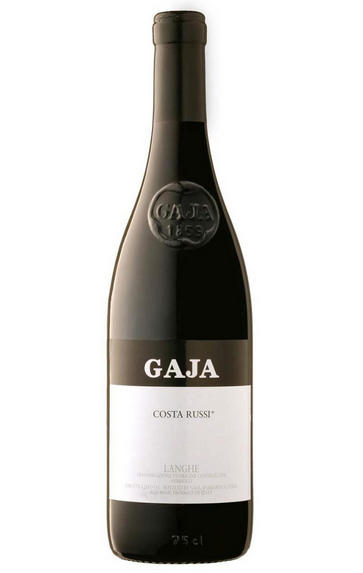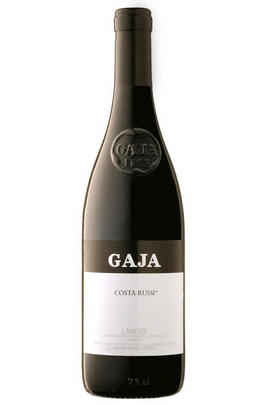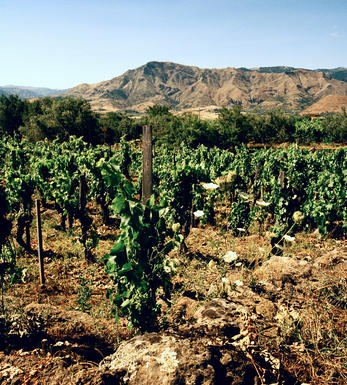
2014 Barbaresco, Costa Russi, Gaja, Piedmont, Italy

Critics reviews
Soft contours, silky tannins and sweet, perfumed fruit are some of the signatures in the 2014 Costa Russi. As always, Costa Russi is the most polished and open-knit of these wines in its youth. Succulent fruit, hard candy and lifted, perfumed aromatics give the 2014 considerable early appeal, but I expect time in bottle will work its usual magic. Today, the 2014 is showing only the barest hint of its potential. Even in the early going, though, the Costa Russi is a totally sexy wine.
The Gaja family's 2014 Barbarescos are more than worthy follow ups to the stellar 2013s. The 2014s also show a bit more stylistic cohesion throughout the range than was the case with the 2013s. Overall, the 2014s are defined by their energy, tension and brilliant personalities. As good as Gaja's cru wines are, the straight Barbaresco - which is a blend of many top sites - is as good or nearly as good as those wines. It is also much more accessibly priced, even if none of these wines can be defined as inexpensive. Sadly, yields are down 35% across the board for the 2014s.
Drink 2024 - 2044
Antonio Galloni, Vinous.com (October 2017)
The 2014 Barbaresco Costa Russi is a beautiful wine that delivers profound color saturation with deep ruby highlights and blackish intensity. I would describe the nose as being more horizontal rather than vertical, if that makes sense. In other words, the bouquet makes its approach with wide intensity and large-scale aromas of black fruit, spice, tar, leather and licorice. It offers fewer of the sudden high notes or moments of sharpness that you get in 2013.
Despite the common perception that this was a very cool vintage, the fruit here actually tastes riper and rounder than you might expect. That's because the vintage heat all came toward the end of the growing season, and the Gaja family left fruit on the vines to the end. In the mouth, the wine shows depth and finesse with some stubborn firmness at this young stage. It needs to flesh out further with more bottle aging.
Drink 2020 - 2045
Monica Larner, Wine Advocate (December 2017)
The nose is replete here with dried red cherries, almonds, strawberries, glazed cranberries, some leafy nuances and already some tobacco and cigar box. Full-bodied and very layered with such concentration for this vintage. Firm yet sturdy tannins, no shortage of fine acidity and a long, structured finish. Such depth.
Drink in 2020
James Suckling, JamesSuckling.com (October 2017)
2014 offered a tricky growing season, and some estates produced no single vineyard wines, instead choosing to blend what they had. Barbaresco in general fared better than Barolo. Although this is closed on the nose, the texture is rich and suave, showing breadth of flavour as well as concentration. It's unusually tannic for 2014, but enlivened by spicy notes. It's still rather subdued but has admirable persistence.
Drink 2021 - 2035
Stephen Brook, Decanter.com (May 2018)
About this WINE

Gaja
Angelo Gaja is Italy`s most renowned and dynamic wine personality and his impact on wine production in the last 30 years cannot be overestimated.
Angelo Gaja took over the family business in 1970 and, as he says: *The challenge was to maintain the basic power and depth of Nebbiolo while polishing the wines to give them richer colour, fuller fruit, better balance and a more refined style.'
In pursuit of this aim Gaja replanted many of the vineyards, installed temperature-controlled, stainless steel tanks, introduced the concept of ageing wines in small oak barrels and began releasing single vineyard Barbarescos. Most controversial of all, Gaja planted some Cabernet Sauvignon and Chardonnay on prime Barbaresco land.
Today Gaja has 101 hectares of vineyards divided into 32 separate plots and produces around 30,000 cases of wine a year. Gaja produces world-class wines that sell for world-class prices; his latest venture is in Tuscany where he has acquired an estate in Montalcino.

Barbaresco
The Piedmontese DOCG zone of Barbaresco is responsible for producing some of Italy’s finest wines. It occupies the same region and uses the same grape (Nebbiolo) as its bigger brother Barolo, but is a third of the size (only 640 hectares versus Barolo’s 1,700 hectares). It is also 50 years younger than Barolo, having produced wine labelled Barbaresco since 1890.
Barbaresco earned its DOCG after Barolo in 1980, largely thanks to the efforts of Angelo Gaja. The soils are lighter here than in Barolo – both in colour and weight – and more calcareous. The slopes are also less favourably situated and (relatively speaking) yield earlier-maturing yet extremely elegant wines that require less oak ageing (normally one year in oak plus six months in bottle). The appellation’s key districts are Barbaresco, Treiso, Neive and Alba.
Recommended producers: Cigliuti, Gaja, Marchesi di Gresy

Nebbiolo
Nebbiolo is the grape behind the Barolo and Barbaresco wines and is hardly ever seen outside the confines of Piedmont. It takes its name from "nebbia" which is Italian for fog, a frequent phenomenon in the region.
A notoriously pernickety grape, it requires sheltered south-facing sites and performs best on the well-drained calcareous marls to the north and south of Alba in the DOCG zones of Barbaresco and Barolo.
Langhe Nebbiolo is effectively the ‘second wine’ of Piedmont’s great Barolo & Barbarescos. This DOC is the only way Langhe producers can declassify their Barolo or Barbaresco fruit or wines to make an early-drinking style. Unlike Nebbiolo d’Alba, Langhe Nebbiolo can be cut with 15% other red indigenous varieties, such as Barbera or Dolcetto.
Nebbiolo flowers early and ripens late, so a long hang time, producing high levels of sugar, acidity and tannins; the challenge being to harvest the fruit with these three elements ripe and in balance. The best Barolos and Barbarescos are perfumed with aromas of tar, rose, mint, chocolate, liquorice and truffles. They age brilliantly and the very best need ten years to show at their best.


Buying options
Add to wishlist
Description
Soft contours, silky tannins and sweet, perfumed fruit are some of the signatures in the 2014 Costa Russi. As always, Costa Russi is the most polished and open-knit of these wines in its youth. Succulent fruit, hard candy and lifted, perfumed aromatics give the 2014 considerable early appeal, but I expect time in bottle will work its usual magic. Today, the 2014 is showing only the barest hint of its potential. Even in the early going, though, the Costa Russi is a totally sexy wine.
The Gaja family's 2014 Barbarescos are more than worthy follow ups to the stellar 2013s. The 2014s also show a bit more stylistic cohesion throughout the range than was the case with the 2013s. Overall, the 2014s are defined by their energy, tension and brilliant personalities. As good as Gaja's cru wines are, the straight Barbaresco - which is a blend of many top sites - is as good or nearly as good as those wines. It is also much more accessibly priced, even if none of these wines can be defined as inexpensive. Sadly, yields are down 35% across the board for the 2014s.
Drink 2024 - 2044
Antonio Galloni, Vinous.com (October 2017)
wine at a glance
Delivery and quality guarantee